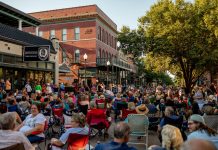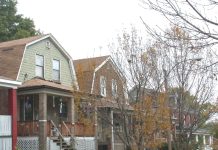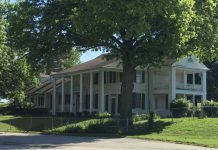
Mill Creek Valley was a predominantly Black neighborhood in St. Louis until 1959, when urban renewal demolished what once was home to 20,000 residents. The area was used to create a highway.
Vivian Gibson is a former resident of Mill Creek Valley and author of “The Last Children of Mill Creek,” which she describes as a book about the people who lived there, more than the location itself.
“The book is about that community, how we lived, how we loved, how we survived, how we saw joy in those kinds of adverse circumstances,” Gibson said.
Gibson’s grandmother, Stella Hodges, was a domestic worker in the work category for Black people at the time. After 20 years of living in Earl, Arkansas, Hodges bought a house in Mill Creek Valley in 1950, where she moved in with her son, daughter-in-law and their eight children. She was unaware that the city was planning to demolish Mill Creek Valley four years later.
On Aug. 7, 1954, Mayor Raymond Tucker announced plans to relocate residents of Mill Creek Valley. Gibson’s book states that Tucker referred to Mill Creek Valley as an “eyesore” to be demolished.
Hodges and her family had no choice but to leave. Gibson was a child when the demolition took place, so she wrote her book from a child’s perspective instead of an adult’s.
Gibson now looks back on what was a segregated city. She has learned more about it, but when she was there, she didn’t know anything different because it had been normalized.
“The problem became the fact that white people didn’t want Black people living near them, so it was convenient to have us contained there,” Gibson said. “But now, that space was wanted for a highway and maybe some redevelopment of the community.”
The demolition of Mill Creek Valley forced the residents to move out with no compensation. It was more painful for Gibson to remember as an adult, reflecting on what society was like and how Black people have struggled to get equity in the world.
In memory of Mill Creek Valley and its residents, a monument called “Pillars of the Valley” was installed. Great Rivers Greenway, an organization that develops a regional network of greenways, partnered with St. Louis City SC and the city of St. Louis to build this tribute.
Emma Klues, vice president of Communications and Outreach for Great Rivers Greenway, explains how “Pillars of the Valley” artist Damon Davis spent time with the residents of Mill Creek Valley to hear their words.
The pillars represent an hourglass, hoisting up the soil on a pedestal because the stories were buried for a long time. Instead of speaking on their behalf, Davis engraved resident quotes onto the pillars.
“Our idea is elevate the voices of the people who are directly impacted, let them tell their stories,” Klues said. “We are just there to help spark the conversation.”
There was no plan for the 20,000 residents who had to scatter across the region in hopes of finding new homes. The displacement affected St. Louis long-term because it added to the distrust of the local government, which Klues says must be repaired.
In addition to damaging civic trust, urban renewal projects in the 1950s had long-term effects on city design. Klues notes that even with new institutions like the soccer stadium, St. Louis is divided by highways, roads and other big barriers that cannot connect across, which is very different from the benefits that Mill Creek Valley provided.
“The city itself lost a neighborhood that was very walkable, self-sufficient and had all those different things that they needed,” Klues said.




